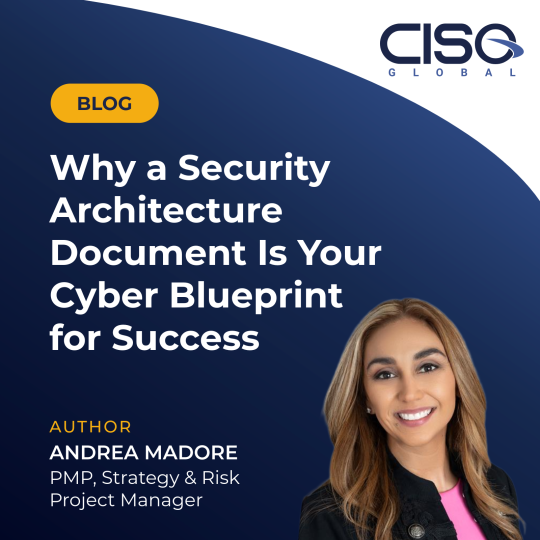Why a Security Architecture Document Is Your Cyber Blueprint for Success
Andrea Madore, PMP, Strategy & Risk Project Manager

If this is your first time creating a security architecture document and you lack the resources or expertise to do so, or if your initial review uncovers gaps in your security that you need help closing, we can help.
Imagine this: You’re planning to construct a skyscraper, but you lack blueprints, so the different entities involved operate with no overall knowledge of what other contractors are doing or the scope or scale of the building. Predictably, disaster ensues. Your foundation is built for a smaller structure, so it can’t support your skyscraper’s weight. Calculations used to situate support between floors were based on incomplete data, leading to cracks that spread and widen. And key city requirements were ignored altogether, so you are slapped with heavy fines until you retrofit your building to comply.

Now, imagine you apply this same ignorance and lack of planning to securing your organization’s digital infrastructure. Your IT department handles the servers and databases – but doesn’t track the internal and external system connections or the data types and data flows the system processes. The procurement department purchases software and hardware – but doesn’t keep an inventory of new or decommissioned machines or end-of-life products. Managers of different departments assign administrative roles and permissions, but there is no access management plan. The legal department gets word that the organization needs to be assessed to show compliance with your industry standard, but no one has maintained updated documentation on data flows or backups, so you struggle through the audit.
Hopefully these scenarios remain in the realm of a wild imagination. Because just like how builders follow detailed blueprints to construct safe buildings, organizations of all sizes should have a security architecture document to serve as their cybersecurity master plan to protect the confidentiality, integrity, and availability of their data from cyber threats.
This security architecture document can actively guide how your organization plans and implements system protections, illustrating how sensitive data flows, who can access what, the controls in place to keep digital assets safe, and the most important areas to expend resources. It can also demonstrate your compliance with critical standards such as NIST, HIPAA, FedRAMP, or ISO/IEC 27001.
How a security architecture document protects your organization
- Protects your organization against ruinous cyber-attacks: This document provides a comprehensive overview of your interconnected systems and pinpoints your system’s vulnerabilities to defend against malware, ransomware, denial of service (DoS) attacks, insider and outsider threats, and other costly attacks. For example, mapping out system dependencies might reveal a forgotten server that’s overdue for a security update that would otherwise serve as a potential gateway for intruders. You can now close this gateway.
- Translates your business requirements into security requirements. Once you understand your organization’s network, firewalls, and detection systems, you can figure out the right blend of protection to safeguard your priorities. And you can then focus resources on the areas that most need them.
- Stay Audit-Ready: No more frantic searches for documentation when your organization undergoes an audit. With a well-documented security architecture, you can quickly provide detailed diagrams and policies that demonstrate compliance.
- Track user roles and responsibilities and permissions. The security architecture can help set authentication verification and access control restrictions so only authorized users can access sensitive data.
- Make smarter decisions: By empowering teams with a clear understanding of your security landscape, you enable quick, consistent action that aligns with your security strategy, whether integrating new technologies, defending against emerging threats, or planning incident response.
- Creates a unified organizational vision: Security, IT, and business teams are often siloed and address different concerns. A well-crafted security architecture bridges these gaps, creating a unified vision to meet the goal of protecting your organization’s data.
How to start
It may sound like a daunting process, but this document does not have to be hundreds of pages. Your first step should be to develop a foundational document that lists the different components of your environment and its security and the types of data you need to protect, both your own and your clients.
This is also a good way to involve the various stakeholders in the process and to translate what may be institutional knowledge into written processes.
It should include:
- Internal and external system connections
- Databases, web servers, hardware, and software
- User types and access levels
- Data classifications
- Identified risks
- Data flow diagrams
Key to its effectiveness is to treat it as a living document/roadmap that tracks how your infrastructure expands or changes, with annual reviews and updates. It can also become your go-to reference for your compliance efforts during audits, as it will include many checkpoints assessors will be reviewing.
If this is your first time creating a security architecture document and you lack the resources or expertise to do so, or if your initial review uncovers gaps in your security that you need help closing, we can help. Our vCISO services can work with your team to develop a comprehensive and organized document. And we can advise you on the most important places to start to protect your data and prevent its loss.